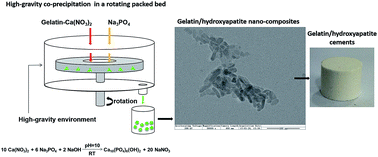This study explored potential use of a high-gravity co-precipitation strategy to synthesize gelatin/hydroxyapatite (Gel/HAP) nano-composites with high protein adsorption efficiencies. The physicochemical properties were characterized using X-ray diffraction, transmission electron microscopy, Fourier transform infrared spectra, thermal gravimetric analysis and Brunauer–Emmett–Teller. Biocompatibility was determined by MTT (3-(4,5-dimethylthiazol-2-yl)-2,5-diphenyl tetrazolium bromide) assays on hFOB 1.19 osteoblast cells. The results confirmed formation of Gel/HAP composites exhibiting nano-rod-like morphologies with high protein adsorption efficiencies and biocompatibilities. In addition, the Gel/HAP nano-composites were molded into cylindrical shaped Calcium Phosphate Cements (CPC), displaying an average compressive modulus of ∼0.6 GPa. The compressive modulus was comparable with that of a human cancellous bone, suggestive of great potential of the Gel/HAP nano-composites in various biomedical applications through serving as bone substitute materials. The high-gravity co-precipitation technique was also applied to synthesize Silk/HAP nano-composites. Therefore, the high-gravity co-precipitation method provides a novel approach for synthesis of various protein/HAP materials.
